Review of Research Trends in Learning and the Internet in Higher Education
Abstract
1. Introduction
2. Justification and Objectives
- To determine the number of the scientific publications with the concepts “learn”, “Internet” and “higher education” in WoS.
- To determine the scientific evolution of “learn”, “Internet” and “higher education” in WoS.
- To specify the most prominent topics for “learn”, “Internet” and “higher education” in WoS.
- To determine the most productive and influential authors regarding “learn”, “Internet” and “higher education” in WoS.
3. Materials and Method
3.1. Research Design
3.2. Procedure and Data Analysis
- -
- Recognition: In this process, the keywords of the publications obtained were analyzed (n = 11,139). Both a co-occurrence node map and a standardized network of co-words were made. To do this, a keyword debugging was performed, finally analyzing 10,443 keywords. Finally, the most incidental themes and concepts were established with a clustering algorithm.
- -
- Reproduction: In this process, a strategic diagram and a thematic network were created based on the principles of centrality and density. Four areas were specified in the figures with their particularities: motor and important issues (upper right area), isolated and entrenched issues (upper left area), issues that are projected or are disappearing (lower left area) and issues with a low and transversal level of development (lower right area).
- -
- Determination: In this process, the elaborated nodes corresponding to the different predetermined periods or time intervals were analyzed. For the study of co-words, five periods were configured, taking as a criterion the scope of 1000 documents per period (P1 = 1993–2005; P2 = 2006–2010; P3 = 2011–2013; P4 = 2014–2016; P5 = 2017–2019). For the authors’ analysis, a single period covering the entire work has been established (PX = 1993–2019). The number of keywords in common between the periods produced the strength of association. The interval diagrams show data on the importance of each of the themes in the established periods, following a process of grouping, taking as a reference the Callon indicators, which study the degree of interaction of a network with respect to other networks, from two perspectives: centrality, which analyzes the strength of external links with other topics, as the measure of the importance of a topic in the development of a certain field of research; and density, which studies the internal strength of the network, analyzing the internal links between all the keywords that are grouped around a specific topic, thus showing the degree of development of the field of study analyzed.
- -
- Performance: In this process, production indicators were established with their relative inclusion criteria to analyze the reported scientific literature. Bearing in mind the indicators listed in Table 1, it can be observed that the unit of analysis focuses on the unit of evaluation itself; in this case, the keywords of the manuscripts. The frequency threshold marks the minimum frequency of intervals, i.e., the minimum required number of keywords or topics that coincide with each other. The type of network generates a multiple connection of co-occurrence of words and authors. The linkage value generates the number of coincidences between thematic networks. The normalization of connections is based on the equivalence index eij = cij2/Root (ci − cj). The clustering algorithm, by means of simple centers, makes the map of subjects and related subnetworks. The evolutionary measure, through the Jaccard Index, shows the similarity measure that elaborates the evolutionary map and the transition map through the inclusion rate.
4. Results
4.1. Scientific Performance and Production
4.2. Structural and Thematic Development
4.3. Thematic Evolution of Terms
4.4. Authors with the Highest Relevance Index
5. Discussion
6. Conclusions
Author Contributions
Funding
Conflicts of Interest
References
- Allen, Liz, Ceri Jones, Kevin Dolby, David Lynn, and Mark Walport. 2009. Looking for landmarks: The role of expert review and bibliometric analysis in evaluating scientific publication outputs. PLoS ONE 4: 1–8. [Google Scholar] [CrossRef] [PubMed]
- Alonso, Sergio, Francisco Javier Cabrerizo, Enrique Herrera-Viedma, and Francisco Herrera. 2010. hg-index: A new index to characterize the scientific output of researchers based on the h-and g-indices. Scientometrics 82: 391–400. [Google Scholar] [CrossRef]
- Baer, Walter S. 1998. Will the Internet Transform Higher Education? Santa Monica: Rand. [Google Scholar]
- Beyth-Marom, Ruth, Eran Chajut, Sonia Roccas, and Lilach Sagiv. 2003. Internet-assisted versus traditional distance learning environments: Factors affecting students’ preferences. Computers & Education 41: 65–76. [Google Scholar] [CrossRef]
- Borko, Hilda, Jennie Whitcomb, and Daniel Liston. 2008. Wicked Problems and Other Thoughts on Issues of Technology and Teacher Learning. Journal of Teacher Education 60: 3–7. [Google Scholar] [CrossRef]
- Carbonell, Xavier, Elena Guardiola, Marta Beranuy, and Ana Bellés. 2009. A bibliometric analysis of the scientific literature on Internet, video games, and cell phone addiction. Journal of The Medical Library Association: JMLA 97: 102–7. [Google Scholar] [CrossRef]
- Cabrerizo, Francisco Javier, Sergio Alonso, Enrique Herrera-Viedma, and Francisco Herrera. 2010. q2-Index: Quantitative and qualitative evaluation based on the number and impact of papers in the Hirsch core. Journal of Informetrics 4: 23–28. [Google Scholar] [CrossRef]
- Chen, Leida, Ravi Nath, and Zhenya Tang. 2020. Understanding the determinants of digital distraction: An automatic thinking behavior perspective. Computers in Human Behavior 104: 1–43. [Google Scholar] [CrossRef]
- Cobo, Manuel Jesús, Antonio Gabriel López, Enrique Herrera, and Francisco Herrera. 2011. Science mapping software tools: Review, analysis, and cooperative study among tools. Journal of the American Society for Information Science and Technology 62: 1382–402. [Google Scholar] [CrossRef]
- Cook, David A., Anthony J. Levinson, Sarah Garside, Denise M. Dupras, Patricia J. Erwin, and Victor M. Montori. 2008. Internet-based learning in the health professions—A meta-analysis. JAMA-Journal of the American Medical Association 300: 1181–96. [Google Scholar] [CrossRef]
- Danet, Brenda, and Susan C. Herring. 2007. The Multilingual Internet: Language, Culture, and Communication Online. Oxford: Oxford University Press. [Google Scholar]
- Datu, Jesús Alfonso, Weipeng Yang, Jana Patricia M. Valdez, and Samuel Kai Wah Chu. 2018. Is Facebook involvement associated with academic engagement among Filipino university students? A cross-sectional study. Computers and Education 125: 246–53. [Google Scholar] [CrossRef]
- Djenic, Sanja, Radojka Krneta, and Jelena Mitic. 2011. Blended Learning of Programming in the Internet Age. IEEE Transactions on Education 54: 247–54. [Google Scholar] [CrossRef]
- Feng, Shihui, Yip Kan Wong, Lai Yin Wong, and Liaquat Hossain. 2019. The Internet and Facebook Usage on Academic Distraction of College Students. Computers and Education 134: 41–49. [Google Scholar] [CrossRef]
- Gogus, Aytac, and Yücel Saygın. 2019. Privacy perception and information technology utilization of high school students. Heliyon 5: 1–9. [Google Scholar] [CrossRef]
- Golonka, Ewa, Anita R. Bowles, Victor M. Frank, Dorna L. Richardson, and Suzanne Freynik. 2012. Technologies for foreign language learning: A review of technology types and their effectiveness. Computer Assisted Language Learning 27: 70–105. [Google Scholar] [CrossRef]
- González-Hernando, Carolina, Lorena Valdivieso-León, and Verónica Velasco-González. 2020. Estudiantes universitarios descubren redes sociales y edublog como medio de aprendizaje. RIED. Revista Iberoamericana de Educación a Distancia 23: 223–39. [Google Scholar] [CrossRef]
- Heradio, Ruben, Luis de la Torre, Daniel Galan, Francisco Javier Cabrerizo, Enrique Herrera-Viedma, and Sebastián Dormido. 2016. Virtual and remote labs in education: A bibliometric analysis. Computers and Education 98: 14–38. [Google Scholar] [CrossRef]
- Hirsch, Jorge. 2005. An index to quantify an individual’s scientific research output. Proceedings of the National Academy of Sciences of the United States of America 102: 16569–72. [Google Scholar] [CrossRef]
- Kaminer, Noam, and Yale M. Braunstein. 1998. Bibliometric analysis of the impact of internet use on scholarly productivity. Journal of The American Society For Information Science 49: 720–30. [Google Scholar] [CrossRef]
- Khiste, Gajanan, and Rajeev R. Paithankar. 2017. Analysis of Bibliometric Term in Scopus. International Journal of Library Science and Information Management 3: 81–88. [Google Scholar]
- Kietzmann, Jan H., Kristopher Hermkens, Ian P. McCarthy, and y Bruno S. Silvestre. 2011. Social media? Get serious! Understanding the functional building blocks of social media. Business Horizons 54: 241–51. [Google Scholar] [CrossRef]
- Koparal, Mahmut, Haluk Yener Ünsal, Hilal Alan, Fatih Üçkardeş, and Belgin Gülsün. 2019. WhatsApp messaging improves communication in an oral and maxillofacial surgery team. International Journal of Medical Informatics 132: 1–26. [Google Scholar] [CrossRef] [PubMed]
- Kurt, Mehmet. 2010. Determination of in internet privacy behaviours of students. Procedia—Social and Behavioral Sciences 9: 1244–50. [Google Scholar] [CrossRef]
- López, Jesús, Antonio-José Moreno-Guerrero, Juan Antonio López, and Santiago Pozo. 2019. Analysis of the Productive, Structural, and Dynamic Development of Augmented Reality in Higher Education Research on the Web of Science. Applied Science 9: 5306. [Google Scholar] [CrossRef]
- López, Jesús, Adrian Segura-Robles, Antonio-José Moreno-Guerrero, and Elena Parra-González. 2020. Machine Learning and Big Data in the Impact Literature. A Bibliometric Review with Scientific Mapping in Web of Science. Symmetry 12: 495. [Google Scholar] [CrossRef]
- López-Robles, José Ricardo, José Ramón Otegi-Olaso, Igone Porto, and Manuel Jesús Cobo. 2019. 30 years of intelligence models in management and business: A bibliometric review. International Journal of Information Management 48: 22–38. [Google Scholar] [CrossRef]
- Mangold, W. Glynn, and David J. Faulds. 2009. Social media: The new hybrid element of the promotion mix. Business Horizons 52: 357–65. [Google Scholar] [CrossRef]
- Martínez, Ma Ángeles, Manuel Jesús Cobo, Manuel Herrera, and Enrique Herrera. 2015. Analyzing the scientific evolution of social work using science mapping. Research on Social Work Practice 25: 257–77. [Google Scholar] [CrossRef]
- Montero-Díaz, Julio, Manuel-Jesús Cobo, María Gutiérrez-Salcedo, Francisco Segado-Boj, and Enrique Herrera-Viedma. 2018. Mapeo científico de la Categoría «Comunicación» en WoS (1980–2013). Comunicar 26: 81–91. [Google Scholar] [CrossRef]
- Moorthy, Krishna, Loh Chun T’ing, Khor Mei Wei, Pauline Tan Zi Mei, Chai Yan Yee, Kevin Jia Wern, and Yue Mei Xin. 2019. Is facebook useful for learning? A study in private universities in Malaysia. Computers and Education 130: 94–104. [Google Scholar] [CrossRef]
- Moral-Muñoz, José Antonio, Enrique Herrera-Viedma, Antonio Santisteban-Espejo, and Manuel Jesús Cobo. 2020. Software tools for conducting bibliometric analysis in science: An up-to-date review. El Profesional de la Información 29: 1–20. [Google Scholar] [CrossRef]
- Parra-González, María Elena, and Adrián Segura-Robles. 2019. Producción científica sobre gamificación en educación: un análisis cienciométrico. Revista de Educación 386: 109–31. [Google Scholar] [CrossRef]
- Rana, Nripendra, Emma Slade, Sebastian Kitching, and Yogesh K. Dwivedi. 2019. The IT way of loafing in class: Extending the theory of planned behavior (TPB) to understand students’ cyberslacking intentions. Computers in Human Behavior 101: 114–23. [Google Scholar] [CrossRef]
- Rathbone, Adam, Ruth Norris, Paul Parker, Aidan Lindsley, Anna Robinson, Wasim Baqir, David Campbell, and Andy Husband. 2020. Exploring the use of WhatsApp in out-of-hours pharmacy services: A multi-site qualitative study. Research in Social and Administrative Pharmacy 16: 503–10. [Google Scholar] [CrossRef]
- Rodríguez-García, Antonio Manuel, Jesús López, Miriam Agreda, and Antonio-José Moreno-Guerrero. 2019. Productive, Structural and Dynamic Study of the Concept of Sustainability in the Educational Field. Sustainability 11: 5613. [Google Scholar] [CrossRef]
- Rossing, Jonathan P., Willie M. Miller, Amanda K. Cecil, and Suzan E. Stamper. 2012. iLearning: The Future of Higher Education? Student Perceptions on Learning with Mobile Tablets. Journal of the Scholarship of Teaching and Learning 12: 1–26. [Google Scholar]
- Sakhnini, Jacob, Hadis Karimipour, Ali Dehghantanha, Reza M. Parizi, and Guatman Srivastava. 2019. Security aspects of Internet of Things aided smart grids: A bibliometric survey. Internet of Things 22: 1–47. [Google Scholar] [CrossRef]
- Segura-Robles, Adrián, María Angustias Sánchez-Ojeda, Miguel Ángel Gallardo-Vigil, and Inmaculada Alemany-Arrebola. 2019. Portable tutor: WhatsApp in nursing students¿ internship and final degree Project processes. The European Proceedings of Social and Behavioural Sciences 1: 847–54. [Google Scholar] [CrossRef]
- Sun, Jianrong. 2016. Convergence and Divergence in Blended Learning. In Blended Learning: Aligning Theory with Practices. Edited by S.K.S. Cheung En, L. Kwok, J. Shang, A. Wang and R. Kwan. Berlin/Heidelberg: Springer International Publishing, vol. 9757, pp. 292–301. [Google Scholar] [CrossRef]
- Taylor, James C. 1995. Distance education technologies: The fourth generation. Australasian Journal of Educational Technology 11: 1–7. [Google Scholar] [CrossRef]
- Vázquez-Cano, Esteban, Manuel León Urrutia, María Elena Parra-González, and Eloy López Meneses. 2020. Analysis of Interpersonal Competences in the Use of ICT in the Spanish University Context. Sustainability 12: 476. [Google Scholar] [CrossRef]
| 1 | LINU. This is the abbreviation established by the researchers of this study to describe the use of the Internet in university student learning. |
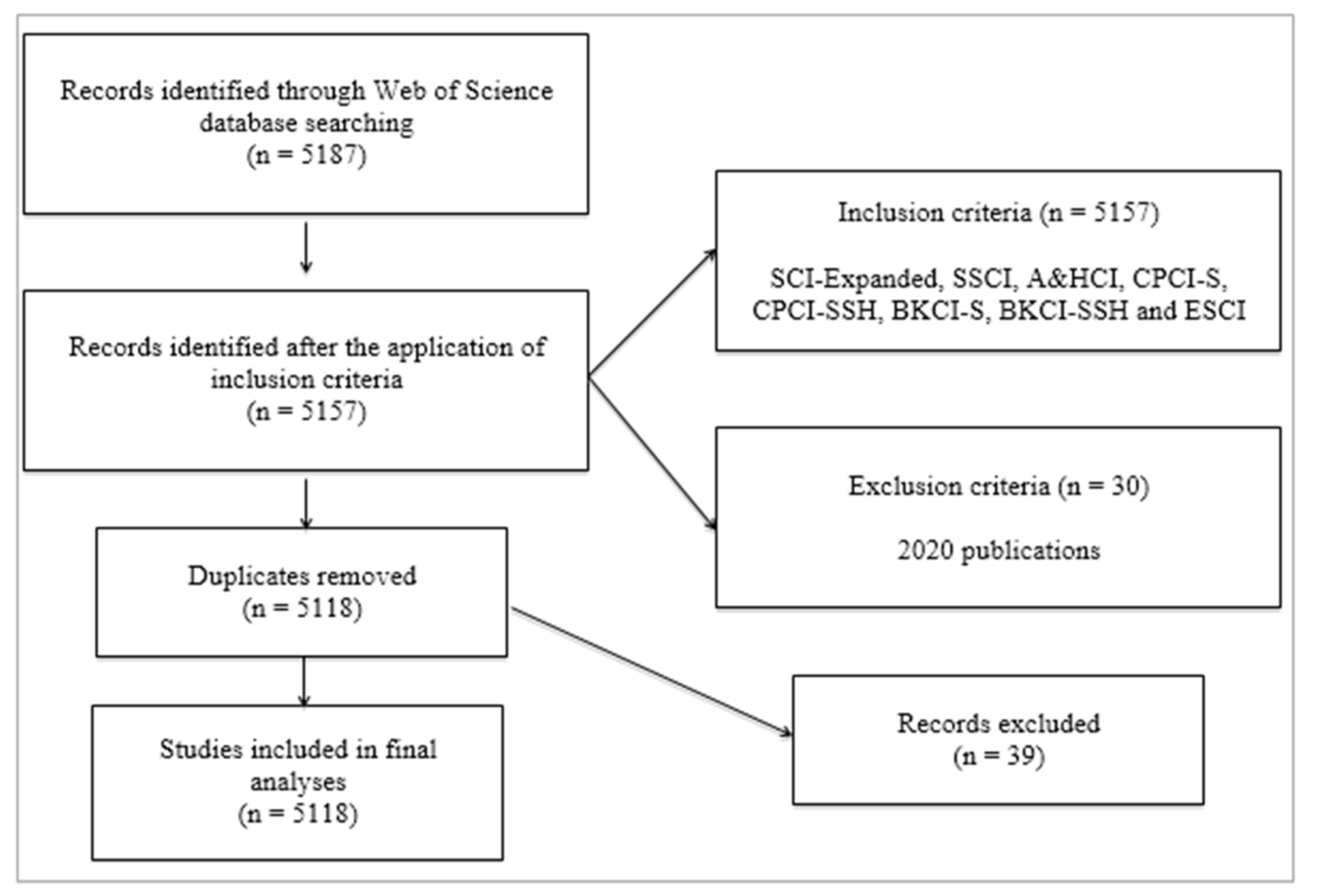
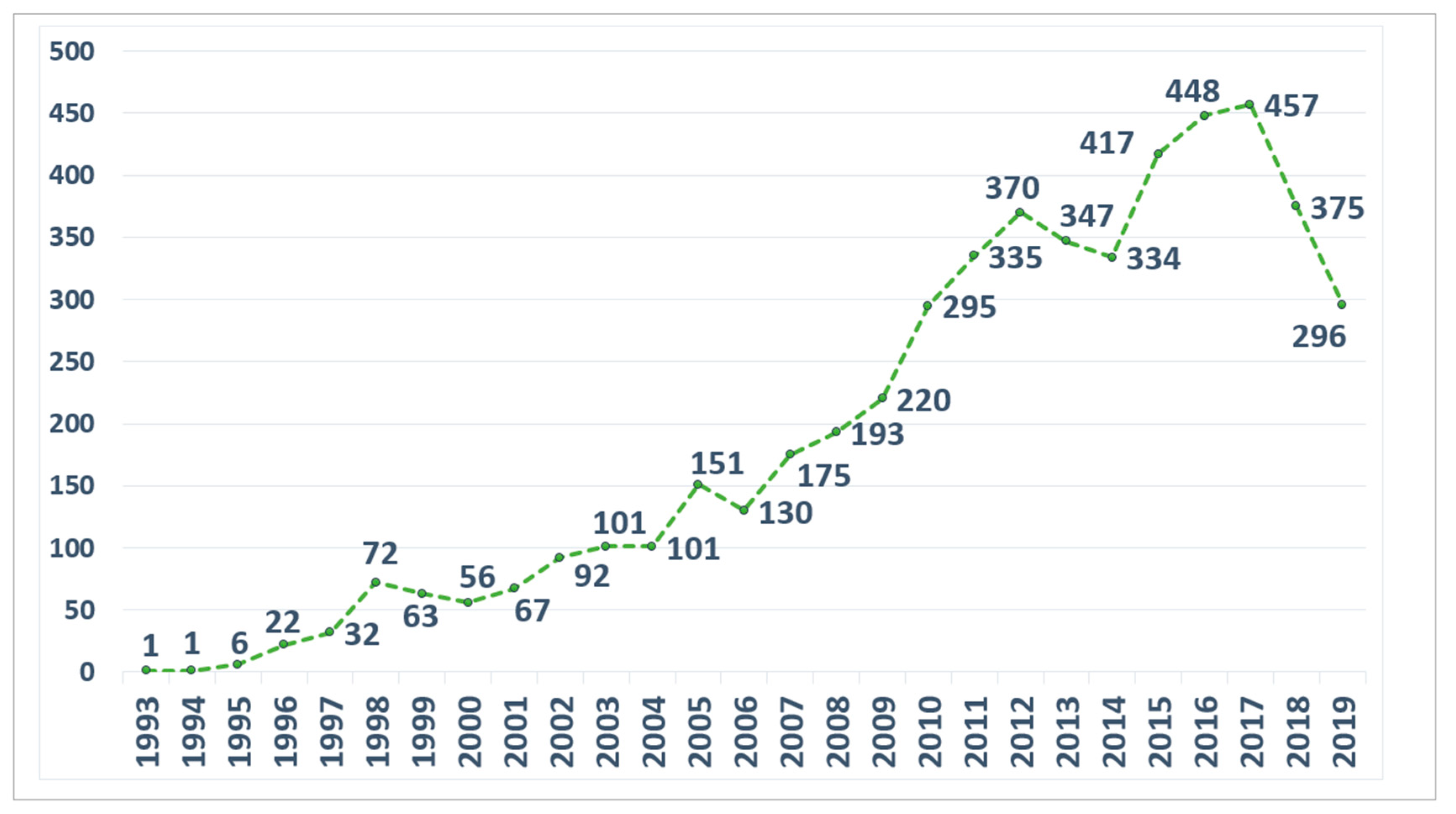

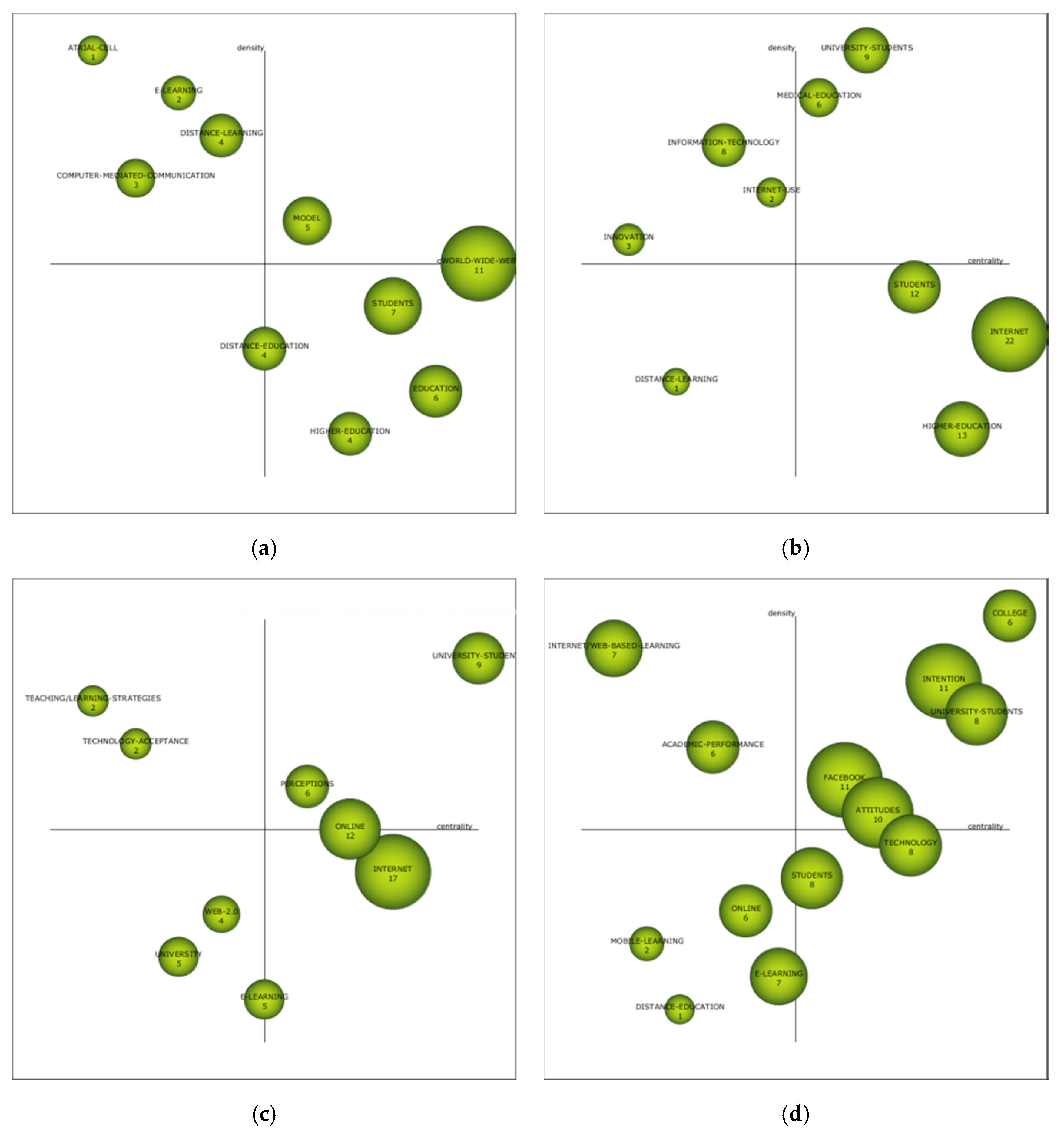
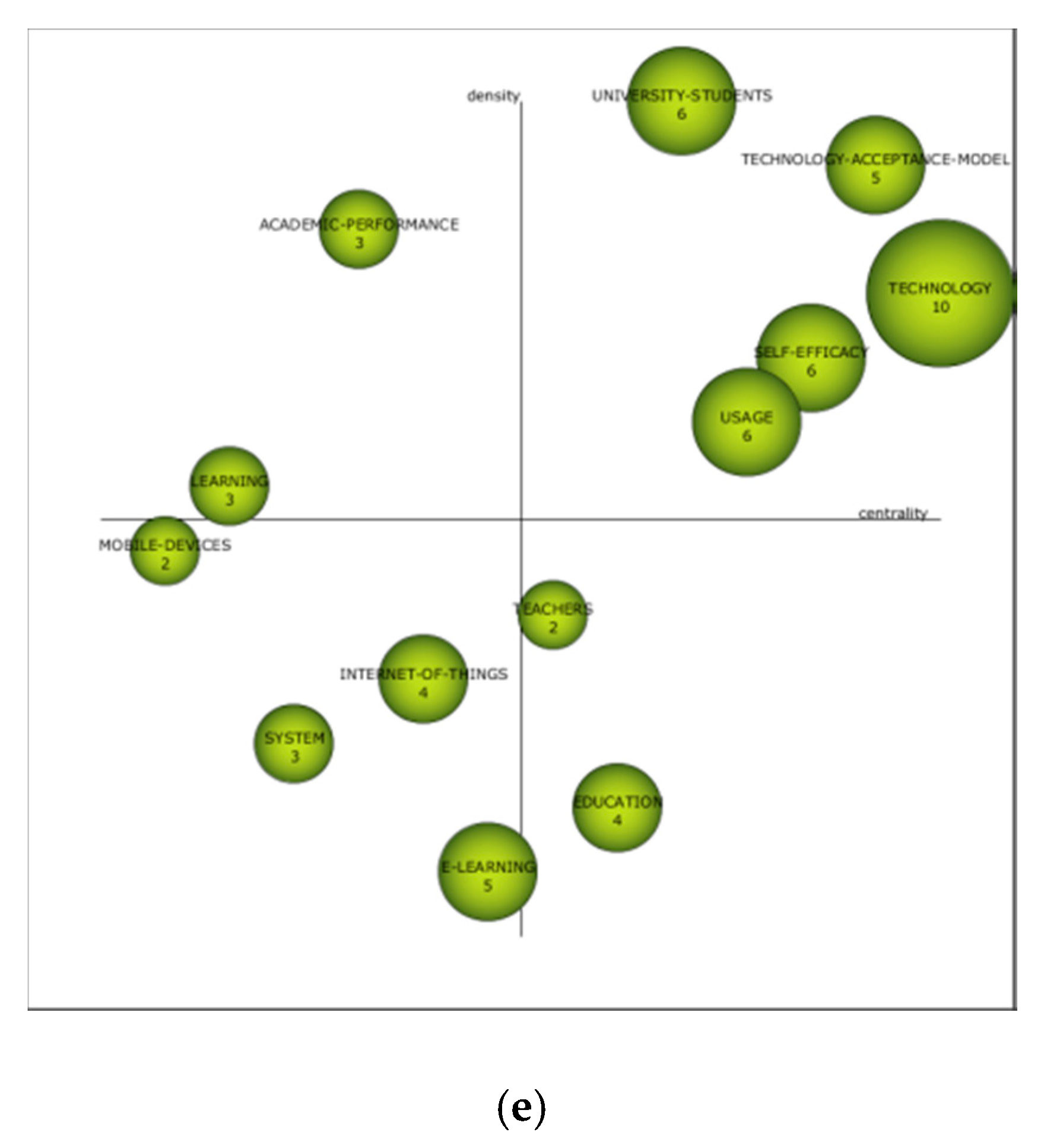
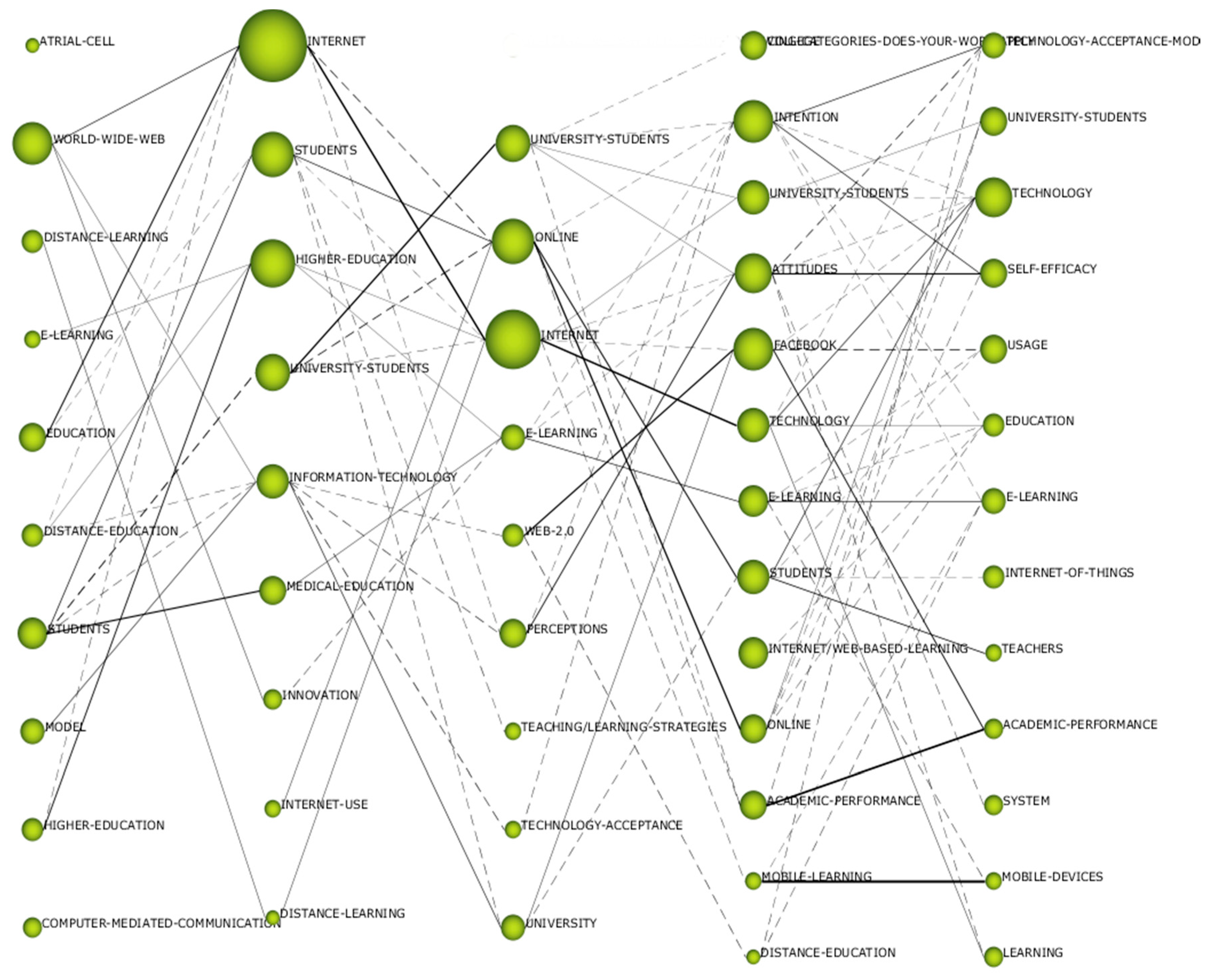
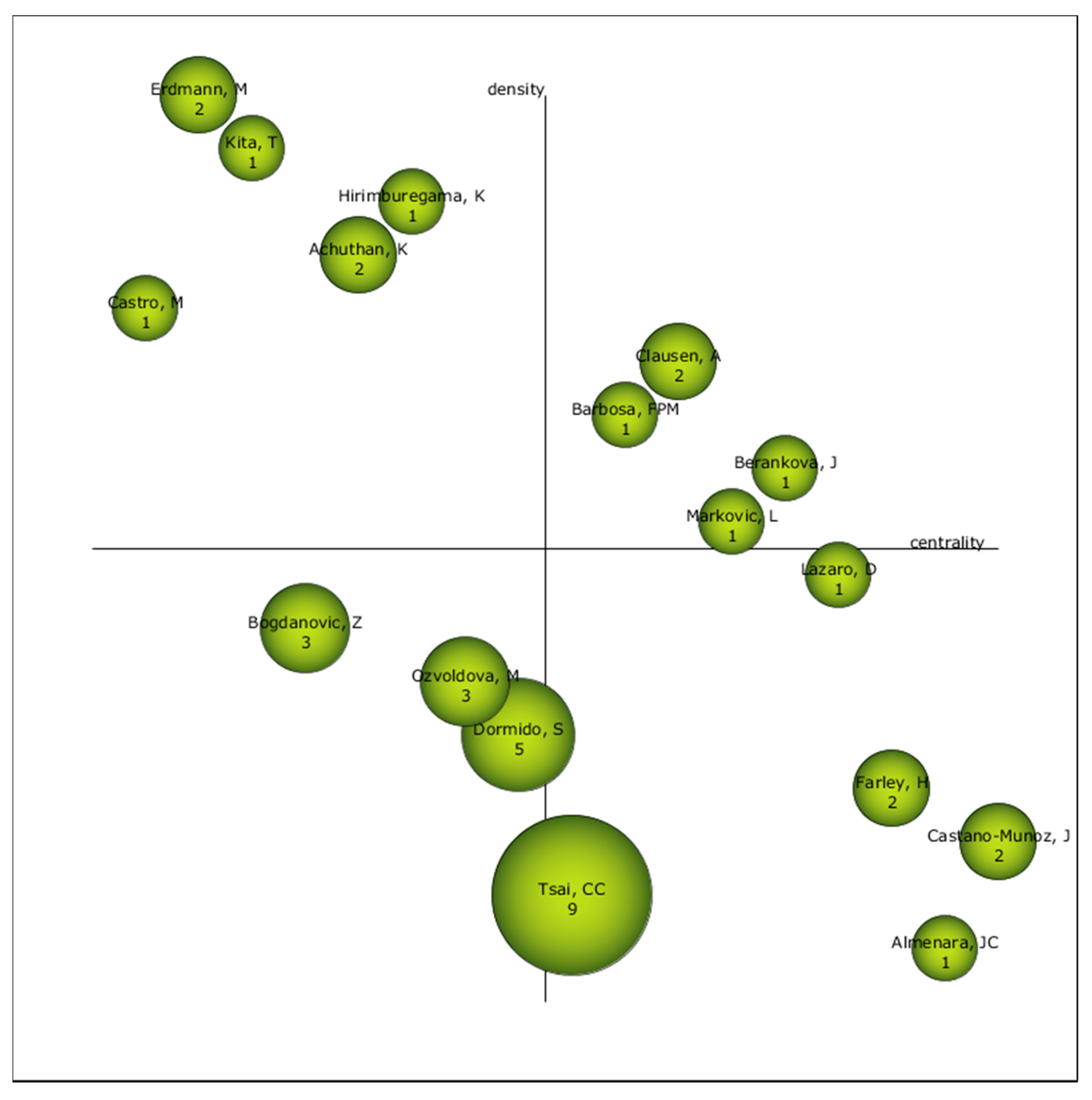
| Configuration | Values |
|---|---|
| Analysis unit | Keywords authors, keywords WoS |
| Frequency threshold | Keywords: P1 = (2), P2 = (5), P3 = (5), P4 = (5), P5 = (5) |
| Authors: PX = (3) | |
| Network type | Co-occurrence |
| Co-occurrence union value threshold | Keywords: P1 = (2), P2 = (3), P3 = (3), P4 = (3), P5 = (3) |
| Authors: PX = (2) | |
| Normalization measure | Equivalence index |
| Clustering algorithm | Maximum size: 9; Minimum size: 3 |
| Evolutionary measure | Jaccard index |
| Overlapping measure | Inclusion Rate |
| Interval 1993–2005 | ||||||
| Title | Works | H Index | G Index | HG Index | Q2 Index | Quotes |
| Atrial-Cell | 5 | 1 | 1 | 1 | 1.41 | 5 |
| World-Wide-Web | 26 | 11 | 22 | 15.56 | 16.25 | 510 |
| Distance-Learning | 14 | 4 | 5 | 4.47 | 6 | 30 |
| E-learning | 10 | 2 | 5 | 3.16 | 13.11 | 93 |
| Education | 17 | 6 | 14 | 9.17 | 11.49 | 197 |
| Distance-education | 13 | 4 | 7 | 5.29 | 6.32 | 53 |
| Students | 12 | 7 | 12 | 9.17 | 16.73 | 260 |
| Model | 5 | 5 | 5 | 5 | 19.62 | 768 |
| Higher-Education | 6 | 4 | 4 | 4 | 6.63 | 41 |
| Computer-Mediated-Communication | 3 | 3 | 3 | 3 | 8.66 | 81 |
| Interval 2006–2010 | ||||||
| Title | Works | H Index | G Index | Hg Index | Q2 Index | Quotes |
| Internet | 88 | 22 | 40 | 22.66 | 30.03 | 1818 |
| Students | 21 | 12 | 18 | 14.7 | 21.91 | 666 |
| Higher-Education | 55 | 13 | 29 | 19.42 | 18.73 | 889 |
| University-Students | 15 | 9 | 13 | 10.82 | 21.63 | 613 |
| Information-Technology | 9 | 8 | 8 | 8 | 19.6 | 507 |
| Medical-education | 9 | 6 | 8 | 6.93 | 11.49 | 189 |
| Innovation | 4 | 3 | 4 | 3.46 | 7.14 | 50 |
| Internet-use | 5 | 2 | 3 | 2.45 | 14.21 | 128 |
| Distance-learning | 7 | 1 | 2 | 1.41 | 4 | 17 |
| Interval 2011–2013 | ||||||
| Title | Works | H Index | G Index | Hg Index | Q2 Index | Quotes |
| University-Students | 20 | 9 | 15 | 11.62 | 13.42 | 327 |
| Online | 23 | 12 | 20 | 15.49 | 15.49 | 472 |
| Internet | 99 | 17 | 27 | 21.42 | 19.77 | 915 |
| E-learning | 32 | 5 | 11 | 7.42 | 6.32 | 143 |
| Web 2.0 | 19 | 4 | 11 | 6.63 | 17.89 | 1408 |
| Perceptions | 13 | 6 | 11 | 8.12 | 10.95 | 157 |
| Teaching/learning strategies | 4 | 2 | 4 | 2.83 | 8.83 | 66 |
| Technology-Acceptance | 4 | 2 | 2 | 2 | 8.83 | 71 |
| University | 6 | 5 | 5 | 5 | 6.71 | 120 |
| Interval 2014–2016 | ||||||
| Title | Works | H Index | G Index | Hg Index | Q2 Index | Quotes |
| College | 9 | 6 | 9 | 7.35 | 10.39 | 108 |
| Intention | 22 | 11 | 19 | 14.46 | 17.23 | 376 |
| University-Students | 21 | 8 | 12 | 9.8 | 12 | 160 |
| Attitudes | 30 | 10 | 18 | 13.42 | 15.17 | 357 |
| 49 | 11 | 18 | 14.07 | 14.83 | 392 | |
| Technology | 41 | 8 | 14 | 10.58 | 12.65 | 240 |
| B-learning | 45 | 7 | 10 | 8.37 | 8.37 | 147 |
| Students | 23 | 8 | 12 | 9.8 | 12 | 154 |
| Internet/Web-Based-Learning | 14 | 7 | 14 | 9.9 | 15.2 | 269 |
| Online | 16 | 6 | 8 | 6.93 | 7.35 | 79 |
| Academic-performance | 8 | 6 | 8 | 6.93 | 17.66 | 236 |
| Mobile-learning | 9 | 2 | 5 | 3.16 | 6.63 | 36 |
| Distance-education | 6 | 1 | 2 | 1.41 | 3.61 | 14 |
| Interval 2017–2019 | ||||||
| Title | Works | H Index | G Index | Hg Index | Q2 Index | Quotes |
| Technology-Acceptance-model | 34 | 5 | 8 | 6.32 | 7.42 | 74 |
| University-Students | 21 | 6 | 8 | 6.93 | 6.93 | 80 |
| Technology | 134 | 10 | 18 | 13.42 | 17.03 | 454 |
| Self-efficacy | 32 | 6 | 7 | 6.48 | 7.35 | 83 |
| Usage | 29 | 6 | 8 | 6.93 | 9.49 | 84 |
| Education | 29 | 4 | 4 | 4 | 4.47 | 32 |
| E-learning | 36 | 5 | 10 | 7.07 | 7.42 | 108 |
| Internet-of-things | 19 | 4 | 8 | 5.66 | 8.25 | 80 |
| Teachers | 11 | 2 | 6 | 3.46 | 8 | 46 |
| Academic-performance | 10 | 3 | 6 | 4.24 | 5.2 | 37 |
| System | 8 | 3 | 5 | 3.87 | 3.87 | 25 |
| Mobile-devices | 9 | 2 | 3 | 2.45 | 4.24 | 15 |
| Learning | 10 | 3 | 4 | 3.46 | 3.87 | 40 |
© 2020 by the authors. Licensee MDPI, Basel, Switzerland. This article is an open access article distributed under the terms and conditions of the Creative Commons Attribution (CC BY) license (http://creativecommons.org/licenses/by/4.0/).
Share and Cite
Segura-Robles, A.; Moreno-Guerrero, A.-J.; Parra-González, M.-E.; López-Belmonte, J. Review of Research Trends in Learning and the Internet in Higher Education. Soc. Sci. 2020, 9, 101. https://doi.org/10.3390/socsci9060101
Segura-Robles A, Moreno-Guerrero A-J, Parra-González M-E, López-Belmonte J. Review of Research Trends in Learning and the Internet in Higher Education. Social Sciences. 2020; 9(6):101. https://doi.org/10.3390/socsci9060101
Chicago/Turabian StyleSegura-Robles, Adrián, Antonio-José Moreno-Guerrero, María-Elena Parra-González, and Jesús López-Belmonte. 2020. "Review of Research Trends in Learning and the Internet in Higher Education" Social Sciences 9, no. 6: 101. https://doi.org/10.3390/socsci9060101
APA StyleSegura-Robles, A., Moreno-Guerrero, A.-J., Parra-González, M.-E., & López-Belmonte, J. (2020). Review of Research Trends in Learning and the Internet in Higher Education. Social Sciences, 9(6), 101. https://doi.org/10.3390/socsci9060101








